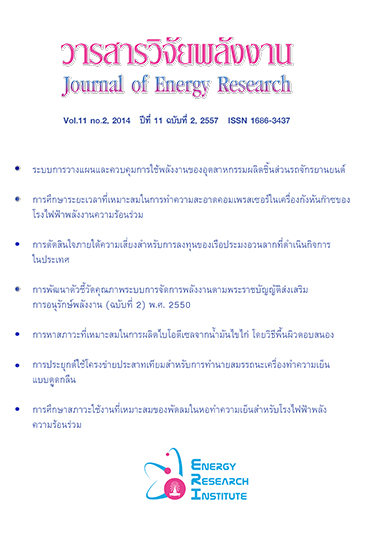การศึกษาสภาวะใช้งานที่เหมาะสมของพัดลมในหอทำความเย็นสำหรับโรงไฟฟ้าพลังความร้อนร่วม
Main Article Content
Abstract
บทความนี้นำเสนอการศึกษาความสัมพันธ์ของจำนวนพัดลมที่ใช้งานสำหรับหอทำความเย็นชนิดใช้พัดลม ดูดออก (Mechanical-Induced Draft Cooling Tower) ที่มีผลต่อกำลังการผลิตสุทธิของโรงไฟฟ้าพลังความร้อนร่วม พระนครใต้หน่วยที่ 3 ขนาดกำลังการผลิตรวม (Gross Capacity) 2×246 MW (GTs) + 1×275.6 MW (ST) โดยมีปัจจัยเกี่ยวข้องที่สำคัญได้แก่ จำนวนพัดลมสำหรับหอทำความเย็น อุณหภูมิบรรยากาศกระเปาะแห้ง ความชื้นสัมพัทธ์และร้อยละของกำลังการผลิตของโรงไฟฟ้า ทั้งนี้ ในการปรับลดจำนวนพัดลมของแต่ละสภาวะได้กำหนดให้อัตราการใช้เชื้อเพลิงมีค่าคงที่ จากผลการศึกษาพบว่า ความสัมพันธ์ระหว่างจำนวนพัดลมที่ใช้งานและกำลังการผลิตสุทธิมีลักษณะเป็นฟังก์ชันโพลีโนเมียลกำลังสี่สำหรับสองตัวแปร กรณีที่โรงไฟฟ้าเดินเครื่องที่กำลังการผลิตฐาน (Base Load) และอุณหภูมิ กระเปาะเปียกมีค่าต่ำกว่า 16 องศาเซลเซียส กำลังการผลิตสุทธิของโรงไฟฟ้าจะเพิ่มขึ้นเล็กน้อยเมื่อปรับลดจำนวนพัดลมลงจากจำนวนพัดลมทั้งหมด 14 หน่วย และให้ผลเช่นเดียวกันที่อุณหภูมิกระเปาะเปียก 17 และ 18 องศาเซลเซียส เมื่อเดินเครื่องที่กำลังการผลิตร้อยละ 75 และ 50 ตามลำดับ อย่างไรก็ตาม การใช้งานพัดลมครบทุกหน่วยที่สภาวะอากาศเย็นจะส่งผลให้กำลังการผลิตสุทธิลดลงได้ จากการศึกษาสามารถสรุปได้ว่า การใช้งานจำนวนพัดลมสำหรับหอทำความเย็นอย่างเหมาะสมจึงเป็นอีกแนวทางหนึ่งในการปรับปรุงสมรรถนะโรงไฟฟ้าโดยไม่มีค่าใช้จ่าย
A STUDY OF APPROPRIATE COOLING TOWER FAN OPERATING FOR A COMBINED CYCLE POWER PLANT
Suwattana Wapinanon1 and Sompong Putivisutisak2
1Inter-Department of Energy Technology and Management Graduate School, Chulalongkorn University
2Department of Mechanical Engineering, Faculty of Engineering, Chulalongkorn University
This study investigates the effect of cooling tower fan operation on net power plant output and proposes appropriate operating conditions at various ambient and load percentages for a fourteen-cell mechanical draft cooling tower. Numerical analysis is performed by using a heat balance simulation software, GateCycleTM. The plant operation and design data of South Bangkok combined-cycle power plant block III with gross capacity 2×246 MW (GTs) + 1×275.6 MW (ST) are applied in the model to demonstrate as a case study. Base cases with constant gas turbine’s heat rate are considered with four primary parameters, i.e., the number of operating fans, ambient dry bulb temperature, relative humidity and load condition.
The study reveals that the impact of cooling tower fan cells operation on net output is a polynomial function of two variables of the fourth power. In case of base load operation, when ambient wet bulb temperature is below 16°C, if the number of operating fans is reduced, the net power plant output will be slightly increased. The results are practically similar for the cases at power plant load 75% and 50% at wet bulb temperature of 17°C and 18°C, respectively. However, when all fans are fully operated the net output is decreased. It can be concluded that the operating number of cooling tower fans can be optimized to improve plant performance at virtually no cost.

